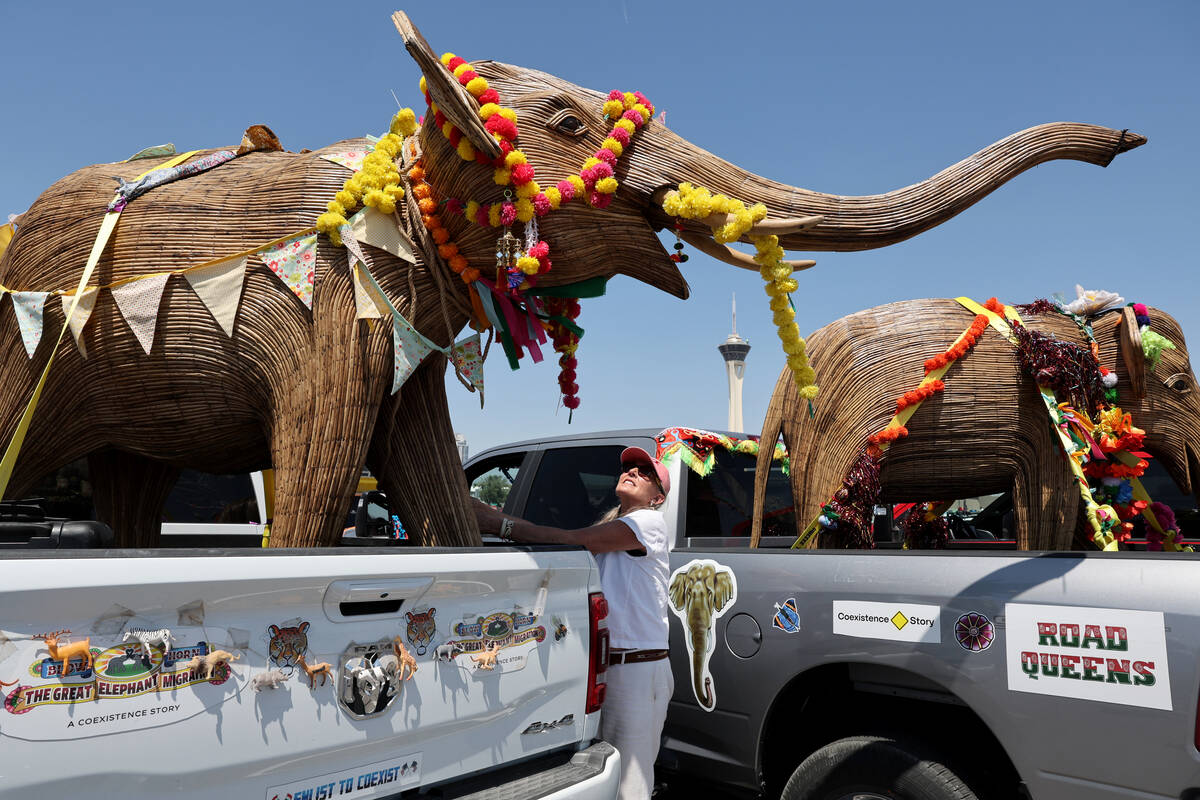‘The best migration ever’: A tusk force of ‘elephants’ takes on the Las Vegas Strip

Twenty-five pickup trucks and three flatbeds carried woven elephant sculptures into Las Vegas Wednesday morning. One after another, the elephant-laden trucks arrived in the parking lot of the Historic Commercial Center District as locals crowded around to see them. Within minutes, the elephants numbered 100 in total and the organizers broke into a spontaneous dance party to celebrate the journey’s success and near-finale.
The train of pickups arrived in Las Vegas about an hour earlier than anticipated, after wrapping up a recent stop in Salt Lake City. Clark County Commissioner Tick Segerblom greeted the convoy and presented Ruth Ganesh, co-founder of the Great Elephant Migration, with the Key to the Strip.
“Elephants are endangered, so (we do) anything we can to participate and publicize it,” Segerblom told the Las Vegas Review-Journal. “But the fun part for me is that this is a good use of the Strip.”
Around noon, the intricately woven elephants, adorned with bright-colored flags and ribbons, traveled south down the Strip. They began near the Sahara, escorted by the Metropolitan Police Department. They later exited the Strip around Russell Road, headed west toward their final destination: Los Angeles, where organizers will display the elephants for one month.
“America has been the best migration ever with this herd,” Ganesh said. “People have been hooting us, getting behind us, buying them off the trucks, putting them in their gardens, supporting us in every way. It’s just been like a dance-a-thon with the herd.”
The Great Elephant Migration has raised several million dollars to support Indian artists and more than 20 conservation organizations, according to Ganesh. On its 5,000-mile nationwide tour, which began last July, organizers have sold nearly 400 elephants, with prices ranging from $8,000 to $22,000.
The elephants have proven so compelling, Ganesh added, that they have attracted a star-studded clientele of buyers — including Cher, Chris Martin, King Charles III and Indian Prime Minister Narendra Modi.
As the cavalcade has crisscrossed the U.S. for the past year, Ganesh said, organizers have received shipments along the way to replenish their stock of the elaborate elephants.
Sarath Gopalan is an Indian artist who traveled with the migration. He said it takes about two weeks to construct the steel frame for each elephant, then another two and a half months to wrap the frame in an intricate weave.
“I’m really excited to see how much people around the world are loving the elephants, and how it’s causing so much excitement and attracting bringing so many people together from different parts of the world, and, of course, raising money to support conservation projects around the world,” Gopalan said through a translator.
Roughly 300 Indian artists, including Gopalan, weave the elephants using lantana camara, an invasive, wood-stemmed shrub which eradicates native plants and is toxic to many animals. By using lantana to create the elephants, they aim to remove the deadly weed from Indian forests and raise awareness for human-animal coexistence.
That mission brought Vegas local Victoria Hart to the parking lot Wednesday morning to see the elephants. When the elephants stopped in Miami Beach late last year, Hart was there. When she learned the same procession would make its way through her hometown, she was ecstatic.
“It’s an amazing art experience, as well as the emotional connection,” Hart said. “I literally felt like I had a spiritual experience when I saw them on the beach.”
The mission-driven elephant motorcade has stopped in countless cities on its year-long voyage: New York, Houston and Jackson Hole, to name a few. Nothing, however, topped the warm reception and celebratory dance party in the hot Vegas parking lot.
“On this long trip we’ve been on, Vegas is the most fun,” Migration spokesperson Allison Brainard said.
Contact Isaiah Steinberg at isteinberg@reviewjournal.com. Follow @IsaiahStei27 on X.